As it happened Australia-US nuclear submarine deal to counter China NSW records 1351 new COVID cases Victoria records 514
1 of 8
Good evening and thank you for reading our live coverage of the day’s events. If you are just joining us now, here’s what you need you know:
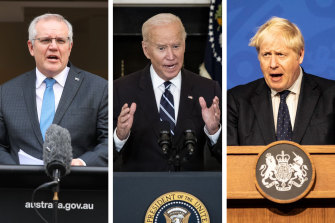
Scott Morrison, Joe Biden and Boris Johnson launched the AUKUS alliance on Thursday morning.
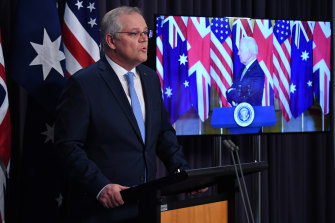
Prime Minister Scott Morrison at this morning’s joint press conference with US President Joe Biden and British Prime Minister Boris Johnson.Credit:AAP

The new submarines will not be in operation for years.Credit:General Dynamics
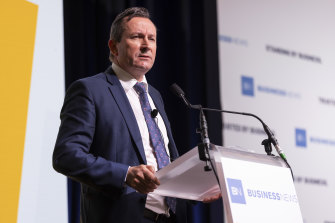
West Australian Premier Mark McGowan.Credit:Matt Jelonek
West Australian Premier Mark McGowan claimed the federal government had “turned its back†on the state after it selected South Australia for the location of its maintenance program for the country’s existing Collins class submarines.“Clearly the Collins class submarines are based in Western Australia and the work should be done at Henderson, 6 kilometres from where they are based,†he said.

NSW Health Minister Brad Hazzard at today’s press conference.Credit:Rhett Wyman
NSW’s Deputy Chief Health Officer Dr Marianne Gale says she’s “cautiously optimistic†the state has reached a peak in its current outbreak. “It’s pleasing at the moment to see our case numbers are stable. We do know they bounce around a little bit,†Dr Gale said. “But we know that even single events can cause a peak in numbers.â€

NSW Deputy Chief Health Officer Dr Marianne Gale.Credit:Rhett Wyman
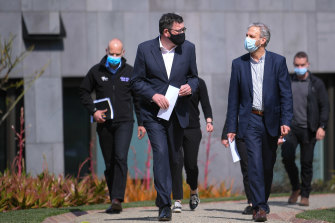
Premier Daniel Andrews, Chief Health Officer Brett Sutton and COVID-19 response commander Jeroen Weimar.Credit: Eddie Jim

The ACT’s lockdown was extended this week by four weeks to October 15.Credit:Alex Ellinghausen
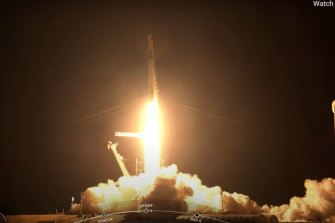
Making history: SpaceX’s Inspiration4 launches, carrying an all-civilian crew into orbit.
Elon Musk’s SpaceX has blasted American billionaire Jared Isaacman into orbit alongside his two contest winners and a health care worker who survived childhood cancer, the Associated Press reports. It is the first chartered passenger flight for SpaceX and a big step in space tourism by a private company, the first time in 60 years of human spaceflight that no professional astronaut is aboard an orbit-bound rocket. The spacecraft is expected to orbit Earth for three days.
This is Michaela Whitbourn signing off on the blog for now. I’ll be back tomorrow morning.
Work has stopped on a level crossing removal project in Melbourne’s north east after a worker tested positive for COVID-19.
The worker did a 12-hour overnight shift at the Maroondah Highway in Lilydale from 6pm on Sunday but, after they developed symptoms on Monday, they did not return to the site.

A level crossing removal worker has tested positive for COVID-19. Credit:Eddie Jim
The worker tested positive for coronavirus on Wednesday, leading the project to come to a halt while deep cleaning and contact tracing is underway.
A Level Crossing Removal Project spokeswoman said it was working closely with the Department of Health to ensure the safety of its workforce.
“All [Major Transport Infrastructure Authority] project sites, including the Level Crossing Removal Project, have strict rules around physical distancing, wearing masks, QR check-in codes and increased industrial cleaning,†the spokeswoman said.
“This is ramping up even further to support the government compliance blitz and ensure our workers are doing the right things to stay safe.â€
The case comes as Victorian authorities have announced a crackdown on the state’s construction industry, with first dose COVID-19 vaccinations mandatory from 11.59pm on Thursday, September 23.
There is also a ban on crossing the metro-regional boundary for work, and on eating or drinking indoors at worksites.
The construction industry, currently operating at 25 per cent of capacity, has come into the spotlight amid claims of tradespeople not wearing masks and infections linked to worksites, including cases that led to Ballarat being locked down on Wednesday.
Premier Daniel Andrews called Thursday’s mandate a “down payment†on construction reopening to 50 and 75 per cent in the coming weeks and months.
“This is a plan to keep the thing open, rather than doing what you could do, and that’s to say ‘oh well, we’re just going to close it down to zero’,†the Premier said.
Victorian health authorities have warned of COVID-19 sewage detections in the regional cities of Ballarat and Wangaratta, and in the Latrobe Valley in the state’s east.
The Chief Health Officer’s update, issued on Thursday evening, said there had been “repeated unexpected detections†in Ballarat East between Sunday, September 12 and Wednesday, September 15.
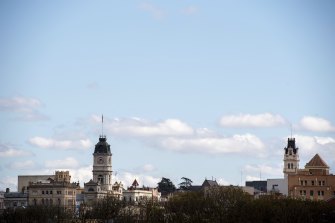
Ballarat residents began their first day of a week-long snap lockdown on Thursday.Credit:Penny Stephens
The unexpected detections in that area were in suburbs including Ballarat East, Ballarat North, Bakery Hill, Black Hill, Brown Hill, Buninyong, Canadian, Eureka, Golden Point, Mt Clear, Mt Helen, Invermay Park, Wendouree, Lake Wendouree, and Warrenheip.
Ballarat residents began their first day of a week-long snap lockdown on Thursday as the number of positive cases in the city of about 100,000 climbed to six.
Victorian health authorities identified a number of new tier-2 COVID-19 exposure sites at Ballarat on Thursday evening, including a pharmacy and a butcher.
The period of interest for Wangaratta and surrounds was between Sunday, September 12 and Tuesday, September 14, with detections in suburbs including Wangaratta, East Wangaratta, North Wangaratta, Wangaratta South, Laceby, Milawa, Oxley, Waldara, and Wangandary.
For the Moe area in the Latrobe Valley, the period of interest was Monday, September 13 to Tuesday, September 14, with authorities flagging detections in not only Moe, but also in Newborough, Trafalgar, Yallourn, and Yarragon.The detections in Moe came after the Gippsland Region Public Health Unit urged the community on Thursday to remain vigilant and get tested for COVID-19.
“Primary close contacts that have had a test and received a negative result, should get re-tested if symptomatic,†the public health unit said in a statement.
The Victorian government flagged on Thursday that support for businesses in the state’s regional areas would continue through September.
Businesses eligible under the Business Costs Assistance Program and Licensed Hospitality Venue Fund would continue to receive payments from it for the last two weeks of the month, regardless of whether they were in the locked-down Ballarat or metropolitan Melbourne.
Some 2,300 eligible cafés, restaurants, hotels and bars in regional areas would also continue to receive payments from the Licensed Hospitality Venue Fund.
Chinese foreign ministry spokesman Zhao Lijian has slammed Australia’s new defence pact with the US and the UK at a press briefing in Beijing late on Thursday.
He described the AUKUS alliance, which includes an agreement for Australia to acquire a fleet of nuclear-powered submarines using technology shared by the US and the UK, as extremely irresponsible and said it would intensify the arms race in the region.
“The US, UK and Australia are engaging in cooperation in nuclear-powered submarines that gravely undermines regional peace and stability, aggravates the arms race and hurts the international non-proliferation efforts,†he said.
“Australia is a non-nuclear weapon state party to the NPT [non-proliferation treaty] and a party to the nuclear weapon-free zone in the Southern Pacific.
“Now it is importing nuclear-powered submarine technology with strategic military value. The international community, including neighbouring countries, have reason to question its commitment to nuclear non-proliferation. China will closely monitor the situation.â€
Zhao Lijian enraged Scott Morrison last November by posting a faked image of an Australian soldier murdering an Afghan child.
In his strongest comments on any Chinese government action since he became Prime Minister, Mr Morrison said at the time that the image was “truly offensive†and “repugnantâ€.
The daily vaccine numbers arrived from the health department a bit later than usual today, but the updated data is now up in our vaccine tracker dashboard.
The progress bars at the top of this blog have updated as well (although you may need to refresh the page for the changes to appear).
The data shows that nationwide 69.8 per cent of those aged 16 and above have received their first vaccine dose, and that in Victoria 69.3 per cent of those aged 16 and above have received their first dose.
This might, at first glance, seem to contradict what Prime Minister Scott Morrison said this morning: “Today we will hit 70 per cent of the country aged over 16 who have had their first dose.â€
It doesn’t. Keep in mind that the update in the vaccine numbers that was released today covers the total number of vaccine doses administered to the end of yesterday.
Based on the current rate of first doses, it is almost certain that sometime today that the 70 per cent first dose milestone will be crossed, but the data that provides the confirmation won’t be released until tomorrow.
The same goes for Victorian Premier Daniel Andrews’s comment earlier that Victoria was set to reach its 70 per cent first dose target sometime today.
That is looking exceedingly likely, based on the state’s current first dose progress, but it will take until tomorrow for the data to say for sure.
Victoria’s Department of Transport has released maps of what Melbourne’s public transport blackout will look like on Saturday as authorities move to thwart an anti-lockdown rally planned for the city’s streets.
Victoria Police Chief Commissioner Shane Patton announced on Wednesday that public transport in and out of the city would be halted from 8am to 2pm on Saturday.
In addition, hard barriers would be set up to lock down the CBD, and more than 2000 police officers would be patrolling the streets, doling out $5500 fines to anyone who did turn up to protest.
The department’s map of what the CBD’s train network will look like between 8am and 2pm on Saturday shows a large portion of the city greyed out; from Coburg in the north to Elsternwick in the south, and from Sunshine in the west to Clifton Hill in the east.
See that map below:
The second map depicts what the tram outage will look like in the CBD between 8am and 2pm on Saturday.
See that map here:
Victoria is home to 43,000 fewer people than at the start of the pandemic, making it the only state in the nation to record a drop in population since coronavirus hit Australia.
The state shrank by about enough people to fill the Victorian border city of Wodonga in the 12 months to March, according to Australian Bureau of Statistics data.
Victoria’s population has declined 0.6 per cent since the pandemic hit, as international border closures to stop the spread of the virus meant offshore migration failed to make up for those leaving the state.
In every other state and territory there was an increase in residents, ranging from a modest 0.1 per cent population growth in NSW to a high of 0.9 per cent in Queensland.
Nationally there was a 0.1 per cent increase, or about 35,700 people, compared to 1.5 per cent growth in 2019 before the pandemic hit. The Australian population is now 25,704,340, including 6,648,600 people living in Victoria.
Queensland benefited from people moving into the state from other parts of the country, while Victoria was most negatively affected by migration as people moved interstate or overseas.
Read the full story here.
A Melbourne church and emergency department are among new COVID-19 exposure sites identified by Victorian health authorities.
Anyone who attended those venues at the specified times must immediately get tested for COVID-19 and quarantine for 14 days from the exposure, regardless of whether they receive a negative test result.
Also declared tier-1 sites were Story House Early Learning at Diamond Creek, and TopGear Wheels and Tyres at Heidelberg West, both in Melbourne’s north east.
The early learning centre is a close contact site on Monday, September 6 and Friday, September 10 between 9am and 4pm, while the tyre shop’s exposure period is on Thursday, September 9 and Friday, September 10 between 8am and 5.30pm.
The remainder of new exposure sites are tier-2, including the Casey Hospital emergency department main department, as well as medical clinics and a radiology centre in Melbourne’s south east. Tier-2 contacts must get tested urgently for COVID-19 and isolate until receiving a negative result.
A full list of Victorian exposure sites can be found here.
Dozens of people at Noah’s Backpackers Bondi in Sydney’s eastern suburbs are in quarantine after a COVID-19 case was detected at the hostel.

Dozens of people at Noah’s Backpackers Bondi in Sydney’s eastern suburbs are in quarantine.Credit:Edwina Pickles
South Eastern Sydney Local Health District today confirmed one case had been identified at the beachfront accommodation on Campbell Parade.
Following the detection, testing was offered on-site on Tuesday, September 14 and thorough cleaning was undertaken.
“There are around 70 people staying at the facility,†the health district said in a statement. “The Public Health Unit is supporting residents to quarantine within the facility.â€
South Eastern Sydney LHD said the situation in each hostel is carefully assessed and monitored, and prevention measures are implemented according to risk.
Noah’s Backpackers Bondi was contacted by the Herald this afternoon and chose not to comment.
On its website, it states due to social distancing guidelines, all dorm rooms are operating at no more than 50 per cent capacity. The shared dorms traditionally sleep four, six or eight people.
West Australian Premier Mark McGowan has claimed the federal government had “turned its back†on the state after it selected South Australia for the location of its Collins Class submarine maintenance program.
The long-awaited decision came amidst the announcement of a new trilateral partnership between the US, British and Australian governments called AUKUS, under which Australia will build nuclear submarines using US technology in South Australia that could be based at the HMAS Stirling Naval Base.
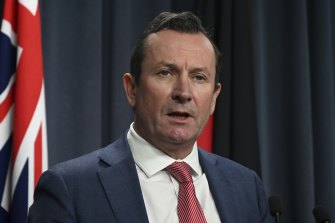
WA Premier Mark McGowan.Credit:Peter de Kruijff
The work would have been worth about $8.4 billion for the WA economy and, during question time in State Parliament, Mr McGowan said he was disappointed in the decision, given the compelling business case his government had presented to the Commonwealth.
He said the Morrison government had “let our great state downâ€.
“Today’s decision by the Liberals and Nationals is not a decision in the national interest,†he said.
“Today, the Liberals and Nationals have turned their backs on Western Australia and Western Australian businesses and Western Australian workers.
“This is a decision that should not have been made, South Australia is already getting the overwhelming majority of Defence work into their shipbuilding industry there in Port Adelaide.
“Clearly the Collins Class submarines are based in Western Australia and the work should be done at Henderson, six kilometres from where they are based.â€
The McGowan government has waged a three-year campaign urging the Commonwealth to move the maintenance, known as full cycle docking, to Western Australia, claiming it would inject about $8.4 billion into the economy over the lifetime of the contracts.
Last year, it spent $87 million on infrastructure upgrades at the Australian Marine Complex in Perth’s shipbuilding hub of Henderson, as a carrot to bring the work west.
But that campaign has come to naught with Prime Minister Scott Morrison announcing the Commonwealth would invest $6.4 billion to begin major upgrades to extend the life of the Collins Class fleet and keep full cycle docking at the Osborne Naval Shipyard in Adelaide.
Mr McGowan called on the federal government to allocate a “significant proportion†of its upcoming multibillion defence works program to WA.
1 of 8
0 Response to "As it happened Australia-US nuclear submarine deal to counter China NSW records 1351 new COVID cases Victoria records 514"
Post a Comment